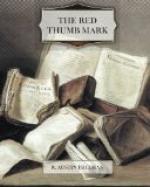From this room we entered the laboratory, a large apartment, one side of which was given up to chemical research, as was shown by the shelves of reagents that covered the wall, and the flasks, retorts and other apparatus that were arranged on the bench, like ornaments on a drawing-room mantelpiece. On the opposite side of the room was a large, massively-constructed copying camera, the front of which, carrying the lens, was fixed, and an easel or copyholder travelled on parallel guides towards, or away, from it, on a long stand.
This apparatus Thorndyke proceeded to explain to our visitors while Polton was fixing the “Thumbograph” in a holder attached to the easel.
“You see,” he said, in answer to a question from Miss Gibson, “I have a good deal to do with signatures, cheques and disputed documents of various kinds. Now a skilled eye, aided by a pocket-lens, can make out very minute details on a cheque or bank-note; but it is not possible to lend one’s skilled eye to a judge or juryman, so that it is often very convenient to be able to hand them a photograph in which the magnification is already done, which they can compare with the original. Small things, when magnified, develop quite unexpected characters; for instance, you have handled a good many postage stamps, I suppose, but have you ever noticed the little white spots in the upper corner of a penny stamp, or even the difference in the foliage on the two sides of the wreath?”
Miss Gibson admitted that she had not.
“Very few people have, I suppose, excepting stamp-collectors,” continued Thorndyke; “but now just glance at this and you will find these unnoticed details forced upon your attention.” As he spoke, he handed her a photograph, which he had taken from a drawer, showing a penny stamp enlarged to a length of eight inches.
While the ladies were marvelling over this production, Polton proceeded with his work. The “Thumbograph” having been fixed in position, the light from a powerful incandescent gas lamp, fitted with a parabolic reflector, was concentrated on it, and the camera racked out to its proper distance.
“What are those figures intended to show?” inquired Miss Gibson, indicating the graduation on the side of one of the guides.
“They show the amount of magnification or reduction,” Thorndyke explained. “When the pointer is opposite 0, the photograph is the same size as the object photographed; when it points to, say, x 4, the photograph will be four times the width and length of the object, while if it should point to, say, / 4, the photograph will be one-fourth the length of the object. It is now, you see, pointing to x 8, so the photograph will be eight times the diameter of the original thumb-mark.”
By this time Polton had brought the camera to an accurate focus and, when we had all been gratified by a glimpse of the enlarged image on the focussing screen, we withdrew to a smaller room which was devoted to bacteriology and microscopical research, while the exposure was made and the plate developed. Here, after an interval, we were joined by Polton, who bore with infinite tenderness the dripping negative on which could be seen the grotesque transparency of a colossal thumb-mark.




